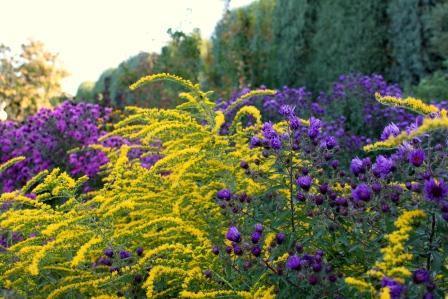Denver Botanic Gardens Loves Pollinators!
This week we’ve taken a few minutes from our busy schedules to consider pollinators and all they do for us and our environment. An earlier post advocated creating a pollinator-friendly habitat around your home or acreage. Here at the Gardens we’ve taken on that challenge as well.
 The basics for pollinator survival - food, water, shelter, and nesting sites - are all easy to provide in a well planned garden. The abundance of food available in the form of nectar and protein-rich pollen on our flowers draws pollinators to the Gardens. There is always something in bloom when pollinators are active, from crocuses in early spring through the last aster of autumn. Horticulturists refer to this as succession planting – planning and planting for continuous bloom. We also often arrange plants in groups or sweeps. This allows for efficient foraging by pollinators; minimal energy is expended flying from one flower to the next.
The basics for pollinator survival - food, water, shelter, and nesting sites - are all easy to provide in a well planned garden. The abundance of food available in the form of nectar and protein-rich pollen on our flowers draws pollinators to the Gardens. There is always something in bloom when pollinators are active, from crocuses in early spring through the last aster of autumn. Horticulturists refer to this as succession planting – planning and planting for continuous bloom. We also often arrange plants in groups or sweeps. This allows for efficient foraging by pollinators; minimal energy is expended flying from one flower to the next.
Many of our gardens at York Street feature or incorporate plants native to our region. This is especially important for attracting and nurturing native pollinators. Our Chatfield and Mount Goliath locations are rich in native foraging opportunities for these important pollinators as well.
The second basic need, water, is accessible in our water features, and droplets from early morning irrigation are handy for a quick sip.
Shelter from inclement weather, from hungry predators, and from inattentive gardeners is readily available for bees and other pollinators in the Gardens as well. An unmulched area of soil can be home to ground-nesting bees that build nest tunnels under ground. Wood-nesting bees can find a home in dead limbs. Since we tend to cut out most dead limbs, we offer an alternative, nest boxes made from hollow reeds or bamboo. These nest boxes are being mounted in protected locations around the garden.
To help protect pollinator species we limit the use of pesticides at the garden. Integrated pest management (IPM) practices are employed to control insect pests and weeds. Cultural practices, mechanical means, and biological controls are all exhausted before we turn to a chemical solution. If chemicals are used, the smallest amount necessary is applied and only in a very targeted manner. When possible chemicals are dispersed early on a cool, calm morning when pollinators are not yet active or before flowers have formed.
Thanks to pollinators we have berries for our breakfast smoothie, tomatoes for our favorite marinara recipe, and pumpkin for pies. And perhaps more importantly, at least in our particular setting, pollinators help our plants set seed that can be harvested, propagated, and returned to the gardens in the form of transplants or shared with other public gardens. Simple steps result in a pollinator-friendly garden and the benefits pollinators provide. We encourage homeowners to join us in welcoming pollinators to the garden.
Add new comment